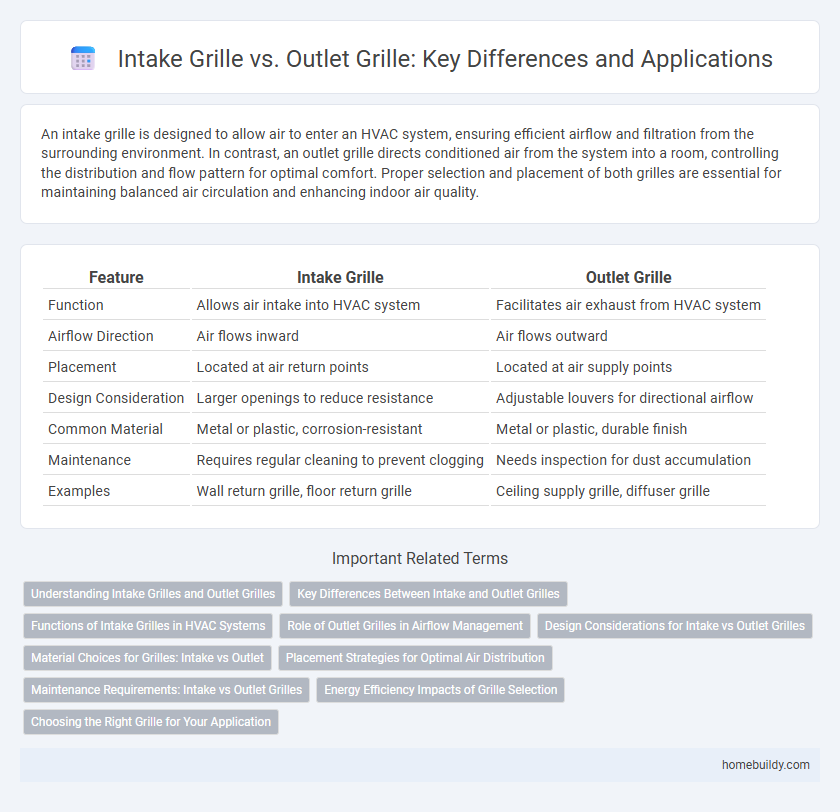An intake grille is designed to allow air to enter an HVAC system, ensuring efficient airflow and filtration from the surrounding environment. In contrast, an outlet grille directs conditioned air from the system into a room, controlling the distribution and flow pattern for optimal comfort. Proper selection and placement of both grilles are essential for maintaining balanced air circulation and enhancing indoor air quality.
Table of Comparison
| Feature | Intake Grille | Outlet Grille |
|---|---|---|
| Function | Allows air intake into HVAC system | Facilitates air exhaust from HVAC system |
| Airflow Direction | Air flows inward | Air flows outward |
| Placement | Located at air return points | Located at air supply points |
| Design Consideration | Larger openings to reduce resistance | Adjustable louvers for directional airflow |
| Common Material | Metal or plastic, corrosion-resistant | Metal or plastic, durable finish |
| Maintenance | Requires regular cleaning to prevent clogging | Needs inspection for dust accumulation |
| Examples | Wall return grille, floor return grille | Ceiling supply grille, diffuser grille |
Understanding Intake Grilles and Outlet Grilles
Intake grilles and outlet grilles serve distinct functions in HVAC systems by managing airflow direction; intake grilles draw air into the system for filtration and conditioning, while outlet grilles distribute conditioned air back into the room. Intake grilles typically feature larger openings and filters to capture dust and debris, ensuring clean air circulation. Outlet grilles often have adjustable louvers to control airflow direction and volume, optimizing comfort and ventilation efficiency.
Key Differences Between Intake and Outlet Grilles
Intake grilles are designed to draw air into HVAC systems, featuring larger openings and filters to trap dust and debris, ensuring clean air intake. Outlet grilles distribute conditioned air into living spaces, often with adjustable louvers to control airflow direction and enhance comfort. The key differences lie in their function, airflow direction, and design features tailored to optimize system performance and indoor air quality.
Functions of Intake Grilles in HVAC Systems
Intake grilles in HVAC systems serve the critical function of allowing air to enter the system for filtration and conditioning, ensuring optimal indoor air quality and system efficiency. These grilles are designed to facilitate smooth airflow, preventing debris from entering the ductwork and enabling consistent air circulation throughout the space. Unlike outlet grilles, which distribute conditioned air back into rooms, intake grilles focus on air intake and filtration, supporting overall HVAC performance and energy savings.
Role of Outlet Grilles in Airflow Management
Outlet grilles play a crucial role in airflow management by directing conditioned air from HVAC systems into occupied spaces, ensuring optimal air distribution and comfort. Unlike intake grilles that draw air into the system, outlet grilles control the velocity and direction of airflow to prevent drafts and maintain balanced room pressure. Proper placement and design of outlet grilles enhance energy efficiency and indoor air quality by promoting effective ventilation and minimizing stagnant air zones.
Design Considerations for Intake vs Outlet Grilles
Intake grilles are designed to maximize airflow efficiency while minimizing noise and debris infiltration, often featuring larger openings and impact-resistant materials. Outlet grilles prioritize controlled air dispersion with adjustable louvers or directional vanes to ensure even distribution and prevent drafts. Both designs must consider placement, airflow volume, and aesthetic integration within the HVAC system for optimal performance and energy efficiency.
Material Choices for Grilles: Intake vs Outlet
Intake grilles are typically made from durable metals like aluminum or steel to withstand debris and environmental exposure, ensuring longevity and efficient airflow intake. Outlet grilles often utilize lighter materials such as plastic or composite alloys that resist corrosion and support smooth air distribution. Selecting appropriate materials for intake and outlet grilles enhances HVAC system performance and minimizes maintenance needs.
Placement Strategies for Optimal Air Distribution
Intake grilles are strategically placed near floor level or low on walls to draw cool air into HVAC systems effectively, while outlet grilles are positioned high on walls or ceilings to distribute conditioned air evenly throughout the space. Optimal air distribution relies on proper placement that considers room size, furniture layout, and airflow patterns to minimize drafts and hot or cold spots. Incorporating adjustable louvers in both intake and outlet grilles enhances control over airflow direction, improving overall ventilation efficiency.
Maintenance Requirements: Intake vs Outlet Grilles
Intake grilles require regular cleaning to prevent dust and debris buildup that can obstruct airflow and reduce HVAC efficiency, while outlet grilles generally need less frequent maintenance but should still be checked to ensure unobstructed airflow and avoid physical damage. Intake grilles often feature filters that must be replaced or cleaned periodically to maintain optimal air quality and system performance. Outlet grilles should be inspected for paint wear or corrosion, especially in high-moisture environments, to prolong their lifespan and maintain aesthetic appeal.
Energy Efficiency Impacts of Grille Selection
Intake grilles and outlet grilles play critical roles in HVAC system efficiency by regulating airflow distribution and pressure balance within ducts. Selecting high-quality intake grilles with optimized open area and low resistance reduces fan energy consumption and enhances airflow, while outlet grilles designed to direct air effectively improve thermal comfort and system performance. Proper grille selection minimizes energy loss, lowers operational costs, and contributes significantly to overall building energy efficiency.
Choosing the Right Grille for Your Application
Selecting the right grille for your HVAC system is crucial for efficient airflow and comfort. Intake grilles are designed to draw air into the system, featuring larger openings and filters to capture dust and debris, which enhances indoor air quality. Outlet grilles, optimized for distributing conditioned air, typically have adjustable louvers to control airflow direction, ensuring even temperature distribution throughout the space.
Intake Grille vs Outlet Grille Infographic

 homebuildy.com
homebuildy.com